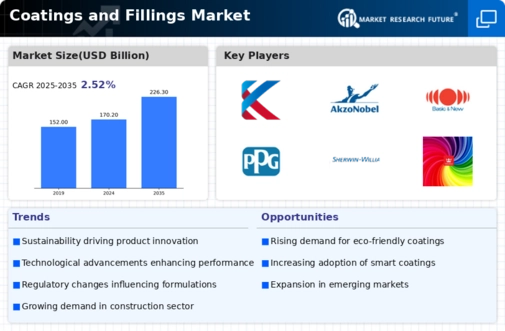Top Industry Leaders in the Coatings Fillings Market
 The Coatings and Fillings market plays a pivotal role in the food processing industry, providing essential ingredients that enhance the taste, texture, and overall appeal of various food products. As of 2023, this market is characterized by a competitive landscape shaped by factors such as consumer preferences for diverse and innovative flavors, clean label trends, and the demand for functional ingredients. Key players strategically position themselves to navigate these dynamics, employing various strategies to maintain or enhance their market share.
The Coatings and Fillings market plays a pivotal role in the food processing industry, providing essential ingredients that enhance the taste, texture, and overall appeal of various food products. As of 2023, this market is characterized by a competitive landscape shaped by factors such as consumer preferences for diverse and innovative flavors, clean label trends, and the demand for functional ingredients. Key players strategically position themselves to navigate these dynamics, employing various strategies to maintain or enhance their market share.
Key Players:
Cargill, Incorporated (U.S.)
Tate & Lyle (U.K.)
Domson Ltd (U.K.)
‘DuPont Nutrition & Health (Denmark)
Archer Daniels Midland Company (U.S.)
Belgostar (Belgium)
Barry Callebaut (Switzerland)
Strategies Adopted:
Key players in the Coatings and Fillings market deploy various strategies to remain competitive. Continuous innovation in product formulations, focusing on clean label ingredients, natural flavors, and reduced sugar content, is a central strategy. These companies invest in research and development to stay ahead of emerging flavor trends and respond to health-conscious consumer demands. Strategic collaborations with food manufacturers, ensuring a strong presence in emerging markets, and adapting to regional variations in flavor preferences contribute to expanding the market reach of Coatings and Fillings products. Marketing efforts often emphasize the versatility and functionality of their products in enhancing the sensory experience of various food applications.
Market Share Analysis:
Market share analysis in the Coatings and Fillings market is influenced by several factors, including brand reputation, product quality, pricing strategies, and distribution efficiency. Companies with strong brand equity and a history of producing high-quality coatings and fillings tend to secure a larger market share. Pricing strategies that balance affordability with the perceived value of these ingredients play a crucial role, given the competition with other flavoring and texturizing agents. Efficient distribution networks, covering both large-scale food processors and small-scale producers, are vital for maintaining a competitive edge in delivering coatings and fillings solutions to a diverse range of customers.
New and Emerging Companies:
While key players dominate the Coatings and Fillings market, new and emerging companies are entering the sector, often focusing on specific flavor profiles or addressing dietary preferences. These entrants may emphasize unique flavor combinations, innovative textures, or cater to specialized markets with tailored coatings and fillings formulations, contributing to the overall diversification and innovation in the market. Although their market share may be relatively modest compared to industry leaders, these companies play a role in driving trends and meeting the evolving demands of food manufacturers and consumers seeking novel and differentiated products.
Industry Trends:
The Coatings and Fillings market has witnessed noteworthy industry news and investment trends in 2023. Key players are investing in sustainable sourcing practices, responding to the growing consumer awareness of environmental impact and ethical sourcing. Collaborations with suppliers of raw materials, efforts to reduce the environmental footprint, and initiatives to support community-based sourcing contribute to maintaining a responsible and transparent supply chain for coatings and fillings production. Additionally, investments in technology adoption, such as advanced processing methods and digital quality control, aim to enhance production efficiency and maintain the quality of coatings and fillings ingredients.
Competitive Scenario:
The overall competitive scenario in the Coatings and Fillings market is marked by intense rivalry among key players striving to capture a larger share of the market. The industry's competitiveness is evident in the emphasis on innovation, sustainability, and strategic collaborations to address evolving consumer preferences and regulatory requirements. The global reach of these companies enables them to adapt to regional variations in food processing practices, capitalize on emerging markets, and navigate complex regulatory landscapes, contributing to the overall dynamism of the industry.
Recent Development in 2023:
Initiatives for the Circular Economy: Some businesses, such as Hempel, have looked into closed-loop methods for recycling old coatings, cutting waste, and enhancing resource efficiency.










